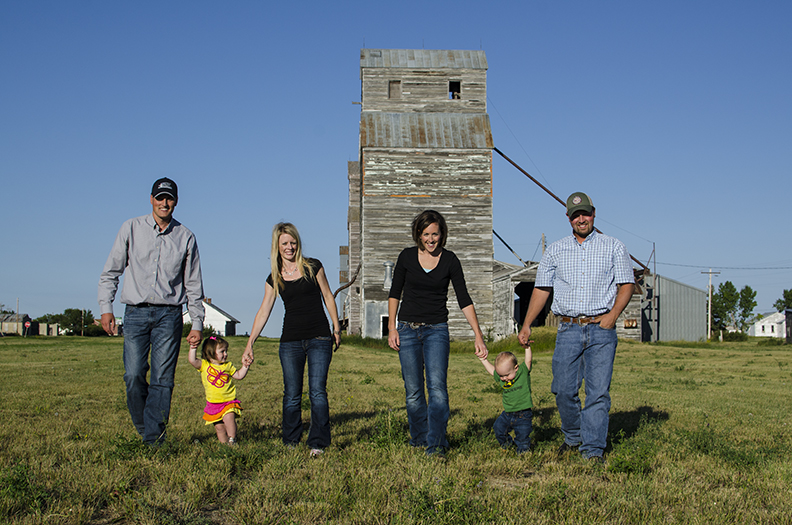
Michael, Cali and Carmen Van Voast and Kelli, Tyson and Colter Cederberg represent a fresh start for the aging community of Turner.
Courtesy Martha Mintz, John Deere’s THE FURROW Magazine,
There was no shotgun start or race to stake a claim, but when Conservation Reserve Program contracts started expiring, a good old-fashioned land rush kicked off in Blaine County, Mont.
“Ten years ago there wasn’t any land to buy,” says newly minted Turner, Mont., farmer Michael Van Voast. “Expiring CRP contracts changed that, creating new opportunities for guys like me that want to come back to the area and give my kids the same opportunities and experiences I had.”
In the past six years, 9.7 million acres of CRP contracts across the United States expired and were not renewed. Thirty-year-old Van Voast and his wife, Carmen, snapped up 2,200 of the 1.47 million acres of well-rested land that came available.
Making moves
Land coming out of CRP isn’t necessarily easy to grab up. Many acres are simply folded back into still-operating farms. However, a continuous stream of income tempts many who have retired or inherited land to keep up CRP contracts. It’s those acres that often come on the market when contracts expire.
But a young family trying to get into farming by purchasing land still has to compete with established farmers with capital and credit.
Just like in past land grabs, it can pay to be a “Sooner” if you can get away with it. Van Voast is one of them. He was able to snap up his CRP acres before they even hit the market.
Working angles.
“As soon as land comes available you have to jump on it or someone else will,” he says.
Working as an ag loan officer at First Bank of Montana in Chinook allowed Van Voast to use his experience loaning money to other young farmers and connections in the community to get the inside track on some CRP acres headed for market.
In his case, the CRP acres were the last holdings of a family that had long left the area but maintained the contracts for the extra income.
“Their attorney knew I was in the market and asked me to make a bid,” Van Voast says of the deal. “I put together a plan, and they went for it.”
To position himself as a more desirable buyer, as compared to established farmers, Van Voast tapped into government programs, such as the Transition Incentive Program (TIP).
“With TIP, a landowner selling CRP acres to a first-time farmer gets two additional years of CRP payments,” Van Voast explains. “That’s a great incentive for the owner to sell to me.”
Van Voast had the capital, so he secured a $300,000 beginning farmer loan from the Farm Service Agency. His bank made up for the rest of the money with an FSA guaranteed loan.
Van Voast isn’t alone. Other young couples have jumped at the chance to return to the area and farm.
Colter and Kelly Cederberg were living in the large city of Billings, Mont., working as a diesel mechanic and a teacher, respectively, when they got the call to come home to Turner.
“My uncle, Max Cederberg, called and asked if I wanted to come home and go farming,” Colter recalls. Max had picked up 1,400 leased acres of expiring CRP ground. “Those leases meant he could continue to support himself and have extra income to bring us back to the farm.”
Colter and Max have secured even more CRP acres that will come available over the next three years, allowing for gradual expansion.
Fresh faces.
Prior to the large influx of available CRP acres, Blaine County was aging, but not retiring.
“These guys don’t believe in retirement,” Colter says. “They want to keep going, and that keeps young families from being able to come in.”
Many former CRP acres are now being farmed by young families, returning life to towns that were fading.
“When my neighbor started farming, he said there were 30 other farmers his age in the county,” Van Voast says. “We’re lucky if there are five other couples our age, but expiring CRP acres are bringing more young people back to the community.”
And they’re happier for it.
“If it weren’t for the CRP leases I would still be in Billings living out of my service truck and motels,” Colter says. Then, he adds this: “It’s a better life here. I come home to my wife and son every night, and I get to raise my family on a farm and in a small community…the same way I grew up.”
copyright 2013 Deere & Company. All worldwide rights reserved.





